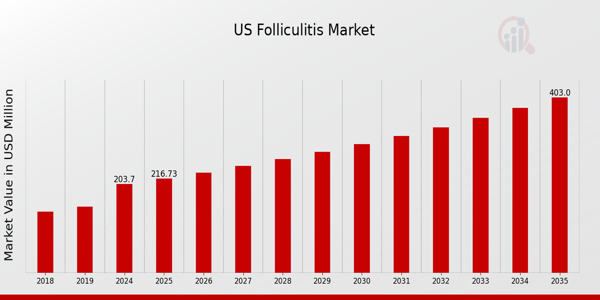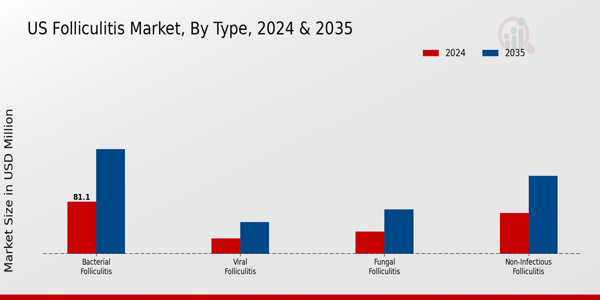US Folliculitis Market Overview
As per MRFR analysis, the US Folliculitis Market Size was estimated at 193.2 (USD Million) in 2023. The US Folliculitis Market Industry is expected to grow from 203.7 (USD Million) in 2024 to 403 (USD Million) by 2035. The US Folliculitis Market CAGR (growth rate) is expected to be around 6.399% during the forecast period (2025 - 2035).
Key US Folliculitis Market Trends Highlighted
The US Folliculitis Market has been witnessing significant trends that are heavily influenced by consumer awareness and lifestyle changes. With the rise in skin conditions linked to factors like increased heat and humidity, more individuals are seeking information on folliculitis, which has spurred the demand for effective dermatological treatments. The key market drivers for this growth include the increasing prevalence of skin infections and the rising awareness regarding personal hygiene.
Many individuals in the US are becoming proactive in their skincare, leading to a more extensive use of over-the-counter products and prescription treatments for folliculitis, often prompted by educational campaigns designed to improve understanding of skin health. Additionally, advancements in dermatological research are creating new opportunities to explore or capture market potential, particularly through innovative treatments and natural skincare solutions. There is a growing trend towards the use of holistic approaches and organic ingredients that appeal to a health-conscious consumer base.
This shift complements the rising awareness and preventive measures against skin disorders in the US. As dermatology clinics and healthcare providers increasingly embrace telehealth services, patients now have easier access to consultations and services, shaping market dynamics as consumer engagement becomes more integrated with technology. Recent trends also indicate a rise in the use of multifunctional skincare products that not only address folliculitis but also cater to broader skin health needs.
Such products tend to attract consumers by promising a holistic approach to skincare. Moreover, with an increasing number of beauty and wellness influencers promoting skincare routines through social media, there has been a shift towards identifying early symptoms and seeking prompt treatment, further driving growth in the US Folliculitis Market. Overall, it is a dynamic environment where consumer education, technological advancements, and a growing inclination towards natural solutions are setting the stage for future development.

Source: Primary Research, Secondary Research, MRFR Database and Analyst Review
US Folliculitis Market Drivers
Increasing Incidence of Folliculitis
The US Folliculitis Market Industry is experiencing substantial growth due to the rising incidence of folliculitis cases among the population. According to the Centers for Disease Control and Prevention (CDC), skin infections, including folliculitis, have been on the rise, with a reported increase of around 8% in skin-related conditions over the past five years. This elevation in cases is attributed to various factors such as increased hygiene awareness and higher occurrences of skin irritations triggered by personal care products.
Furthermore, the American Academy of Dermatology (AAD) highlights that folliculitis often results from bacterial, fungal, or viral infections, necessitating broader access to treatment options. This growing prevalence emphasizes the need for efficient healthcare solutions and directly supports the market growth for folliculitis treatments in the US.
Rising Awareness of Skin Health
In the US, there has been a significant surge in awareness regarding skin health and various dermatological conditions, including folliculitis. Initiatives by organizations such as the American Academy of Dermatology, which promotes annual skin checks and public health campaigns, have led to an increase in the diagnosis and treatment of skin conditions. Awareness campaigns have reportedly increased patient consultations for skin conditions by about 15% in recent years.
This rise in awareness is motivating individuals to seek treatment sooner, directly contributing to the expansion of the US Folliculitis Market Industry as more patients become proactive about managing their skin health.
Advancements in Treatment Options
The US Folliculitis Market Industry is being bolstered by rapid advancements in treatment options available to patients suffering from folliculitis. In recent years, there has been significant Research and Development (R&D) activity aimed at developing new topical and systemic therapies. The Food and Drug Administration (FDA) has approved several innovative treatment modalities, which include new antibiotic formulations and targeted therapies specific to the pathogens responsible for folliculitis.
This evolution in treatment options has the potential to increase recovery rates, with a significant number of patients reporting improvement within weeks of starting prescribed treatments. As the efficacy of treatments continues to grow, it will likely promote further engagement with healthcare professionals, thus enhancing market prospects.
Rise in Skin-Related Health Expenditures
Another driver for the US Folliculitis Market Industry is the observed increase in expenditures related to dermatological health, reflecting a broader tendency in the US healthcare landscape. According to the Health Care Cost Institute, spending on outpatient dermatology services has escalated by over 20% in the past five years, with patients increasingly willing to invest in their skin health. This economic trend indicates a growing acceptance of the importance of treating skin conditions promptly and effectively, which correlates with a higher demand for folliculitis treatments.
This increased spending behavior can be attributed to comprehensive insurance coverage for dermatology services and a greater willingness to seek specialized care, suggesting a positive outlook for market growth.
US Folliculitis Market Segment Insights
Folliculitis Market Type Insights
The US Folliculitis Market exhibits significant growth potential, particularly when analyzed through the lens of various types of folliculitis. This market classification includes Bacterial Folliculitis, Fungal Folliculitis, Viral Folliculitis, and Non-Infectious Folliculitis. Each type presents unique characteristics and treatment protocols that contribute to the overall dynamics of the market.
Bacterial Folliculitis
Bacterial Folliculitis is one of the most prevalent forms, often resulting from skin pore blockages or infections caused by bacteria, like Staphylococcus aureus. This type is critical in understanding the broader market, given the rising incidence of skin infections and the ongoing need for effective antibacterial treatments.
Fungal Folliculitis
On the other hand, Fungal Folliculitis is associated with yeast infections and is increasingly recognized due to its correlation with immunocompromised states, highlighting the need for appropriate antifungal therapies. This segment of the market is particularly relevant as more health practitioners recognize the impact of fungal pathogens, driving demand for effective treatment options.
Viral Folliculitis
Viral Folliculitis, though less common, is significant as it can arise from conditions such as herpes simplex virus infections. The importance of this type stems from the underlying health implications, necessitating advanced antiviral management strategies.
Non-Infectious Folliculitis
Meanwhile, Non-Infectious Folliculitis includes conditions without a clear infectious cause, often linked to irritants, medications, or genetic predispositions. Understanding this classification helps healthcare providers identify prevention and management strategies, making it a noteworthy area of focus for market growth.
The trends observed in these market types indicate rising awareness and diagnosis rates, coupled with the increasing prevalence of skin conditions across different age groups in the US. Moreover, advancements in treatment solutions engender a competitive landscape, benefitting patient outcomes while simultaneously fueling market expansion. This comprehensive segmentation of the US Folliculitis Market assists stakeholders in tailoring products and services that address specific consumer needs, leading to innovative solutions in combating folliculitis across its various forms.

Source: Primary Research, Secondary Research, MRFR Database and Analyst Review
Folliculitis Market Treatment Method Insights
The Treatment Method segment of the US Folliculitis Market shows diverse approaches tailored to managing this skin condition effectively. Topical Antibiotics dominate the treatment landscape due to their targeted action and ease of use, making them a preferred choice among patients and healthcare providers. Oral Antibiotics are also significant, particularly in cases of severe infections, offering systemic relief that topical options may not provide.
Antifungal Medications play a crucial role when folliculitis is caused by fungal pathogens, demonstrating the market's focus on specific pathogen-targeted therapies. Steroid Injections offer rapid alleviation of inflammation and discomfort, serving as an important option for more severe flare-ups. Meanwhile, Laser Therapy has begun gaining traction, known for its long-lasting results and ability to address underlying causes effectively.
Overall, the segmentation within the Treatment Method category reflects a well-rounded approach to folliculitis management in the United States, aligning with trends in personalized healthcare and increasing patient awareness of treatment options. These methods align with the evolving needs of the market, addressing both the prevalence of this condition and the demand for effective interventions.
Folliculitis Market End User Insights
The End User segment of the US Folliculitis Market plays a pivotal role in determining treatment accessibility and efficacy. Hospitals, being key players, offer comprehensive care, advanced diagnostic tools, and a wide range of treatment options for folliculitis, catering to severe cases that require specialized medical attention. Dermatology clinics focus on providing targeted therapies and personalized treatment plans, making them essential in managing mild to moderate folliculitis.
In contrast, Home Care Settings have gained traction as patients increasingly lean towards convenient, cost-effective treatment alternatives. The rising demand for telehealth services has also influenced this market as patients seek remote consultations and treatment solutions from the comfort of their homes.
Overall, the End User segment reflects diverse pathways for treating folliculitis, driven by trends such as the rising incidence of skin disorders and an increasing emphasis on patient-centered care. These dynamics are shaping the US Folliculitis Market landscape, pointing towards growing opportunities for improved treatment options and patient engagement.
Folliculitis Market Distribution Channel Insights
The Distribution Channel segment of the US Folliculitis Market plays a crucial role in the accessibility and availability of treatment options for consumers. Pharmacies are of paramount importance, often serving as the first point of contact for patients seeking relief from folliculitis symptoms, providing easy access to over-the-counter and prescription medications. Online Pharmacies have gained significant traction, especially in the wake of the increasing digitalization of healthcare; they offer convenience and confidentiality for consumers, expanding the reach of treatment options beyond traditional brick-and-mortar locations.
Health and Wellness Stores are increasingly incorporating folliculitis products into their offerings, appealing to health-conscious consumers who seek holistic and preventive approaches. The growing awareness of skin health and the demand for related products contribute to the dynamics of this market segment. With evolving consumer preferences towards online shopping and natural wellness products, adapting to these trends is key for stakeholders within the US Folliculitis Market.
Collectively, these distribution channels not only enhance competition but also ensure that patients are informed of multiple treatment avenues, aligning with the broader trends in the healthcare landscape.
US Folliculitis Market Key Players and Competitive Insights
The US Folliculitis Market is characterized by a competitive landscape comprised of several key players that focus on addressing skin-related conditions associated with hair follicle inflammation. With an increasing prevalence of folliculitis stemming from factors such as poor hygiene, irritation, and bacterial infections, the market is witnessing robust growth fueled by rising consumer awareness about skin health and the variety of treatment options available. Companies in this market strive to innovate and expand their product lines, leading to heightened competition among established pharmaceutical firms and emerging players alike.
Market dynamics are driven not only by therapeutic efficacy but also by branding, distribution channels, and the continuous evolution of treatment protocols, which collectively shape consumer preferences and influence market share.
Teva Pharmaceuticals has made significant inroads within the US Folliculitis Market through its diverse product portfolio and strong focus on generic therapeutics. The company is known for its commitment to delivering high-quality medications at competitive prices, making it a preferred choice among healthcare providers and patients dealing with folliculitis. Teva's strategic emphasis on research and development allows it to continually enhance its offerings, providing effective treatments that meet the varying needs of patients.
Additionally, its extensive distribution network and established relationships with pharmacies further bolster its presence in the US market, enabling better accessibility for consumers seeking folliculitis solutions.
Novartis has positioned itself as a formidable player in the US Folliculitis Market by offering a range of innovative treatments and maintaining a solid reputation for quality and effectiveness. The company's focus on advanced therapies and its commitment to extensive research has led to the development of key products that address folliculitis effectively. Novartis has utilized strategic mergers and acquisitions to strengthen its market presence, enhancing its product offerings and solidifying its position in the competitive landscape.
Furthermore, Novartis emphasizes patient education and outreach initiatives, engaging healthcare professionals and consumers alike to foster a deeper understanding of folliculitis and available treatment options. Through its comprehensive approach to market engagement and product development, Novartis continually reinforces its strengths and commitment to leading the charge in effective folliculitis management within the US region.
Key Companies in the US Folliculitis Market Include
US Folliculitis Market Industry Developments
The US Folliculitis Market has recently seen significant developments, particularly with increased focus on new treatment options and growing awareness of the condition. Teva Pharmaceuticals and Novartis are among companies actively expanding their portfolios, contributing to a more diverse approach in managing folliculitis, particularly through topical and systemic therapies. Current affairs reflect heightened consumer interest as educational campaigns improve awareness surrounding harsh skin conditions.
Major players including AstraZeneca and Merck continue to invest in Research and Development for effective treatments, enhancing their market presence. In terms of mergers and acquisitions, in July 2023, Eli Lilly's acquisition of a dermatological biotech firm was notable, indicating a strategic shift towards incorporating innovative therapies for skin conditions like folliculitis.
Over the past couple of years, Johnson and Johnson and Pfizer have also solidified their stake in the skincare market through collaborations and product launches that directly target folliculitis treatment. Market valuations for these companies have shown substantial growth, influenced by favorable regulatory environments and increasing patient demand in the US, amplifying competition and advancing treatment efficacy in dermatological care.
US Folliculitis Market Segmentation Insights
Folliculitis Market Type Outlook
- Non-Infectious Folliculitis
Folliculitis Market Treatment Method Outlook
Folliculitis Market End User Outlook
Folliculitis Market Distribution Channel Outlook
- Health and Wellness Stores
Report Scope:
| Report Attribute/Metric Source: |
Details |
| MARKET SIZE 2018 |
193.2(USD Million) |
| MARKET SIZE 2024 |
203.7(USD Million) |
| MARKET SIZE 2035 |
403.0(USD Million) |
| COMPOUND ANNUAL GROWTH RATE (CAGR) |
6.399% (2025 - 2035) |
| REPORT COVERAGE |
Revenue Forecast, Competitive Landscape, Growth Factors, and Trends |
| BASE YEAR |
2024 |
| MARKET FORECAST PERIOD |
2025 - 2035 |
| HISTORICAL DATA |
2019 - 2024 |
| MARKET FORECAST UNITS |
USD Million |
| KEY COMPANIES PROFILED |
Teva Pharmaceuticals, Novartis, AstraZeneca, Merck, GlaxoSmithKline, Eli Lilly, Sandoz, Procter and Gamble, Boehringer Ingelheim, Pfizer, Amgen, AbbVie, Sanofi, Johnson and Johnson, Bayer |
| SEGMENTS COVERED |
Type, Treatment Method, End User, Distribution Channel |
| KEY MARKET OPPORTUNITIES |
Increased awareness campaigns, Emerging telehealth services, Enhanced skincare products, Rising demand for effective treatments, Research on novel therapeutics |
| KEY MARKET DYNAMICS |
increasing prevalence of folliculitis, growing demand for topical treatments, rise in awareness and education, advancements in dermatological therapies, prevalence of antibiotic resistance |
| COUNTRIES COVERED |
US |
Frequently Asked Questions (FAQ) :
The US Folliculitis Market is expected to be valued at 203.7 million USD in 2024.
By 2035, the market is projected to reach a valuation of 403.0 million USD.
The CAGR for the US Folliculitis Market is expected to be 6.399% during the forecast period from 2025 to 2035.
Bacterial folliculitis is projected to dominate the market with a valuation of 81.1 million USD in 2024.
The market value for fungal folliculitis is expected to reach 69.5 million USD by 2035.
Major players in this market include Teva Pharmaceuticals, Novartis, AstraZeneca, and Merck.
Non-infectious folliculitis is expected to have a market value of 63.5 million USD in 2024.
The market for viral folliculitis is projected to grow to 49.8 million USD by 2035.
Growth drivers for the market include increasing incidences of skin disorders and advancements in treatment options.
Emerging trends such as innovative therapies and increased awareness about skin health are positively influencing the market's growth.















